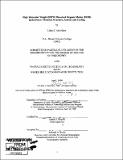| dc.contributor.advisor | Daniel J. Repeta. | en_US |
| dc.contributor.author | Aluwihare, Lihini Indira | en_US |
| dc.contributor.other | Joint Program in Chemical Oceanography. | en_US |
| dc.date.accessioned | 2010-03-25T14:52:00Z | |
| dc.date.available | 2010-03-25T14:52:00Z | |
| dc.date.copyright | 1999 | en_US |
| dc.date.issued | 1999 | en_US |
| dc.identifier.uri | http://hdl.handle.net/1721.1/53038 | |
| dc.description | Thesis (Ph. D.)--Joint Program in Chemical Oceanography (Massachusetts Institute of Technology, Dept. of Earth, Atmospheric and Planetary Sciences; and the Woods Hole Oceanographic Institution), 1999. | en_US |
| dc.description | Includes bibliographical references. | en_US |
| dc.description.abstract | The goal of this thesis was to use high resolution analytical techniques coupled with molecular level analyses to chemically characterize high molecular weight (> 1 k Da (HMW)) dissolved organic matter (DOM) isolated from seawater in an attempt to provide new insights in to the cycling of DOM in the ocean. While a variety of sites spanning different environments (fluvial, coastal and oceanic) and ocean basins were examined, the chemical structure of the isolated HMW DOM varied little at both the polymer and monomer levels. All samples show similar ratios of carbohydrate:acetate:lipid carbon (80±4:10±2:9±4) indicating that these biochemicals are present within a family of related polymers. The carbohydrate fraction shows a characteristic distribution of seven major neutral monosaccharides: rhamnose, fucose, arabinose, xylose, mannose, glucose and galactose; and additionally contains Nacetylated amino sugars as seen by Nuclear Magnetic Resonance Spectroscopy (NMR). This family of compounds, consisting of a specifically linked polysaccharide backbone that is acylated at several positions, has been termed acylated polysaccharides (APS) by our laboratory. APS accounts for 50% of the carbon in HMW DOM isolated from the surface ocean and 20% of the carbon in HMW DOM isolated from the deep ocean. In order to identify a possible source for APS three species of phytoplankton, Thalassiossira weissflogii, Emiliania huxleyi and Phaeocystis, were cultured in seawater and their HMW DOM exudates examined by variety of analytical techniques. Both the T. weissflogii and E. huxleyi exudates contain compounds that resemble APS indicating that phytoplankton are indeed a source of APS to the marine environment. Furthermore, the degradation of the T. weissflogii exudate by a natural assemblage of microorganisms indicates that the component resembling APS is more resistant to microbial degradation compared to other polysaccharides present in the culture. Molecular level analyses show the distribution of monosaccharides to be conservative in surface and deep waters suggesting that APS is present throughout the water column. In order to determine the mechanism by which APS is delivered to the deep ocean the [delta]14C value of APS in the deep ocean was compared to the A14C value of the dissolved inorganic carbon (DIC) at the same depth. If the formation of deep water is the dominant mode of transport then both the DIC and APS will have similar [delta]14C values. However, if APS is injected into the deep ocean from particles or marine snow then the [delta]14C value of APS will be higher than the DIC at the same depth. Our results indicate that APS in the deep Pacific Ocean carries a modem [delta]14C value and is substantially enriched in 14C relative to the total HMW DOM and the DIC at that depth. Thus, particle dissolution appears to be the most important pathway for the delivery of APS to the deep ocean. | en_US |
| dc.description.statementofresponsibility | by Lihini I. Aluwihare. | en_US |
| dc.format.extent | 224 p. | en_US |
| dc.language.iso | eng | en_US |
| dc.publisher | Massachusetts Institute of Technology | en_US |
| dc.rights | M.I.T. theses are protected by
copyright. They may be viewed from this source for any purpose, but
reproduction or distribution in any format is prohibited without written
permission. See provided URL for inquiries about permission. | en_US |
| dc.rights.uri | http://dspace.mit.edu/handle/1721.1/7582 | en_US |
| dc.subject | Joint Program in Chemical Oceanography. | en_US |
| dc.subject | Massachusetts Institute of Technology. Dept. of Earth, Atmospheric and Planetary Sciences. | en_US |
| dc.subject | Woods Hole Oceanographic Institution. | en_US |
| dc.title | High molecular weight (HMW) dissolved organic matter (DOM) in seawater : chemical structure, dources and cycling | en_US |
| dc.title.alternative | High molecular weight dissolved organic matter in seawater : chemical structure, sources and cycling | en_US |
| dc.title.alternative | HMW DOM in seawater | en_US |
| dc.type | Thesis | en_US |
| dc.description.degree | Ph.D. | en_US |
| dc.contributor.department | Joint Program in Chemical Oceanography | en_US |
| dc.contributor.department | Massachusetts Institute of Technology. Department of Earth, Atmospheric, and Planetary Sciences | en_US |
| dc.contributor.department | Woods Hole Oceanographic Institution | en_US |
| dc.contributor.department | Massachusetts Institute of Technology. Department of Ocean Engineering | |
| dc.identifier.oclc | 43874596 | en_US |
